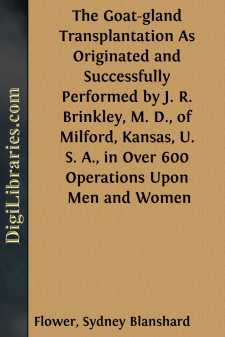Non-Classifiable
- Non-Classifiable 1768
Non-Classifiable Books
Sort by:
by:
Thomas Blossom
No very satisfactory account of the origin and progress of the Postal Service of the country, in its more immediate connection with the local history of Buffalo, can now be compiled. The early records of the transportation service of the Post-Office Department, were originally meager and imperfect; and many of the books and papers of the Department, prior to 1837, were destroyed or lost when the public...
more...
by:
George Berkeley
Part I Query 1. Whether there ever was, is, or will be, an industrious nation poor, or an idle rich? 2. Qu. Whether a people can be called poor, where the common sort are well fed, clothed, and lodged? 3. Qu. Whether the drift and aim of every wise State should not be, to encourage industry in its members? And whether those who employ neither heads nor hands for the common benefit deserve not to be...
more...
AUTHOR’S PREFACE Though dealing exactly with a surgical subject, this book is a layman’s word to laymen. It is an attempt to say to the general public a few things about this amazing work of Dr. J. R. Brinkley, of Milford, Kansas, which he is debarred from saying for himself in this simple form. He has under consideration a book of his own covering the subject of Goat-Gland Transplantation, his...
more...
by:
William Hull
ir, When I venture to inscribe to you the following pages, I am fearless of having applied to me Johnson’s definition of a dedicator, “one who inscribes his work to a patron with compliment and servility.” Adulation, Sir, from any quarter, you would resent as an indignity, and the tenor of my own life and writings will secure me from the imputation of servile deference to others, with whatever...
more...
Locomotion in the Twentieth Century It is proposed in this book to present in as orderly an arrangement as the necessarily diffused nature of the subject admits, certain speculations about the trend of present forces, speculations which, taken all together, will build up an imperfect and very hypothetical, but sincerely intended forecast of the way things will probably go in this new century....
more...
by:
Alexander Whyte
APPRECIATION AND INTRODUCTION The Religio Medici is a universally recognised English classic. And the Urn-Burial, the Christian Morals, and the Letter to a Friend are all quite worthy to take their stand beside the Religio Medici. Sir Thomas Browne made several other contributions to English literature besides these masterpieces; but it is on the Religio Medici, and on what Sir Thomas himself calls...
more...
by:
John Morley
BYRON. It is one of the singular facts in the history of literature, that the most rootedly conservative country in Europe should have produced the poet of the Revolution. Nowhere is the antipathy to principles and ideas so profound, nor the addiction to moderate compromise so inveterate, nor the reluctance to advance away from the past so unconquerable, as in England; and nowhere in England is there...
more...
CHAPTER I. MY BIRTH AND HOME—MY PRETTY COUSIN—ACCIDENT TO THE "KITTYWICH"—JOURNEY TO GUERNSEY—PLEADING TO BECOME A CRUSOE—MY WISH GRANTED—OUTFIT SECURED—SAIL TO JETHOU. That Crusoe of Crusoes, Alexander Selkirk, as I am aware, commences his entertaining history with his birth and parentage, and as I am also a Crusoe, although a very minor adventurer, I may as well follow the...
more...
by:
Anonymous
CHAPTER I. THE DETACHED LEVER ESCAPEMENT. In this treatise we do not propose to go into the history of this escapement and give a long dissertation on its origin and evolution, but shall confine ourselves strictly to the designing and construction as employed in our best watches. By designing, we mean giving full instructions for drawing an escapement of this kind to the best proportions. The workman...
more...
CHAPTER IHISTORY OF THE CATHEDRAL Unlike many of our cathedral cities, "Royal" Winchester has a secular history of the greatest importance, which not only is almost inextricably interwoven with the ecclesiastical annals down to a comparatively recent date, but should at times occupy the foremost position in the records of the place. To attempt, however, to trace the story of the city as well as...
more...











